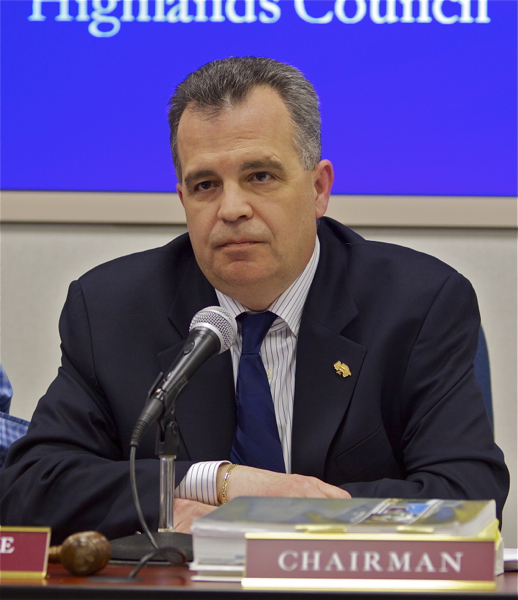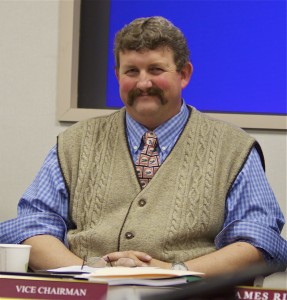Never on Sunday
DEP Commissioner Martin Reflects on First Two Years
With headlines like that, I reveal my age. But, I’m talking about work – never on Sunday!

Whoaa! Down Boy, Down! DEP Commissioner Martin – dressed to kill! He’s softened somewhat after 2 years.
However, I need to bang out [no pun] a quick rebuttal of DEP Commissioner Martin’s “midway” “Q&A” interview with the Star Ledger editorial folks, which was published today.
Martin actually did a very good job spinning a disastrous record. He has greatly improved in his first 2 years in office, in terms of getting the DEP programs straight and delivering a message.
Martin’s early efforts were awkward and the attempts to rigidly “stay on message” came off like transparent spin. But now, he’s effectively managed to integrate the spin into the DEP program lingo, a much more convincing package.
Martin speaks confidently and forcefully. So now, his use of the correct terminology enables a fairly solid rhetorical defense.
Piercing that defense requires that the critic be both substantively informed and adversarial, something very few media professionals and legislators have the time for. Few seem willing to get in this Administration’s face and push back on the bullshit.
So, I thought I’d take a brief shot at laying out the policy criticisms that are implicit in Tom Moran’s set of mostly critical questions and rebut some of Martin’s spin.
Moran was prepared and did a reasonably good job on the questions. But his role in the interview was to give the Administration an opportunity to reflect on the first two years and to provide a platform to defend themselves from increasingly harsh criticisms by environmentalists, legislators and media. Moran’s style and purpose was not to push back against Martin’s claims.
I) Waiver rule
Martin is trying to rename and thereby reframe the waiver rule as akin to a local land use variance – as if he merely renamed the waiver rule the problems would magically disappear (“If we could rename it, we’d call it the variance rule”).
But, to paraphrase the Bard, a turd by any other name is still a turd.
Substantively, Martin continues to mislead by claiming “public emergencies” justify the waiver rule.
But Martin and the Governor don’t need a rule to respond to real emergencies – they already have that power under a Governor’s Emergency Declaration or a Commissioner’s Administrative Order.
Martin was asked to provide an example – his use of flood hazard and site remediation regulations does not make sense (unless Martin has been talking to Pfizer about their plan to leave lots of toxic waste in the Raritan River floodplain at the former American Cyanamid site!).
The objectives of the Flood hazard rules are not in conflict with cleanup – unless Martin is talking about the buffer requirements, which do restrict disturbance and therefore could impact a cleanup.
But the answer to those kind of site specific regulatory conflicts is for the DEP experts to navigate them on a case-by-case basis and craft a workable solution, or to fix the underlying conflicts in the rules themselves. These internal solutions keep DEP in control of the solutions and  assure that any conflicting or competing regulatory objectives are harmonized in a way that maintains environmental safeguards.
There is no need for a waiver rule to provide a flexible, effective, and protective solution.
In contrast to internal DEP resolution, a waiver rule puts control in the hands of the engineers and lawyers for the permittee (applicant/developer), and virtually assures that any “solution” will be driven by economic concerns and surely will undermine environmental safeguards.
II) Transparency – Campaign finance
Martin thinks that website posting of waivers will resolve the fundamental conflicts that will be created by the waiver rule. This is nonsense.
[Update: we told you so: today the Star Ledger’s Auditor reports: Lines already forming for new DEP waiver rule?]
As Moran question notes, there is total lack of transparency on the front end – e.g. from political donations and back room interventions.
Political interventions at DEP occur – as recent criminal indictments of NJ Legislators Van Pelt and Smith have shown – through things like phonce calls and off the record informal meetings in diners where cash changes hands.
New Offices Governor Christie created (e.g. Lt. Governor’s Red Tape reports, Business action center, etc) have made these kind of persistent political problems far worse.
The waiver rule provides the mechanism for the political deal to go though without fingerprints, exactly the opposite of the transparency Martin speaks of.
Before the waiver rule existed, the politicians ran a real risk because the corrupt political deal required a violation of the DEP regulations. That violation could be revealed by a whistleblower, or an intrepid journalist, or expert environmental lawyer or activist.
That detection risk no longer exists as a result of the waive rule.
The deals now comply with the regulations. It is now open season on corruption.
III) Air pollution – Midwestern Coal plant litigation strategy
Martin does not respond to Moran’s question, which exposes the absurdity of Martin’s strategy to invest legal resources in individual plant by plant litigation, as opposed to a blanket EPA rule that applies to ALL plants.
The EPA regulatory approach is faster and far more efficient and cost effective than Martin’s approach. This is obvious!
IV) Barnegat Bay
Moran did a nice job in exposing fatal flaws in Christie’s BB “10 point plan”, e.g. it
- fails to include development restrictions
- actually promotes new development by blocking the removal of environmentally sensitive lands from sewer service areas, which would have occurred under the old DEP WQMP rules, and weakening the enforcement of CAFRA and C1 buffer rules.
- fails to fund necessary infrastructure and storm water management requirements
The only important issues left out was the Governor’s veto of the TMDL bill and Martin’s delegation of DEP science to the new Science Advisory Board. We’ve written about these issues in detail and thus will not repeat all that here.
V) Budget – clean energy diversions
Martin has no reply – Moran could have made this question even stronger by pointing out prior budget diversions of clean energy funds (and termination of RGGI, which while it had no impact on GHG emissions, did fund clean energy).
The Christie Energy Master Plan also erects new “cost benefit” barriers to clean energy and mounts a sham across the board attack on so called renewable “subsidies” and excessively high energy costs due to public policy (a masked attack on the Societal Benefits Charge and a broad array of longstanding energy efficiency and conservation policies).
And, there are many other important DEP budget and parks issues are not addressed.
VI) Fracking
Moran made a technical error and missed the key issue here.
Correcting the error, the threat to NJ from NY and Pennyslvania fracking is NOT from groundwater.
Primary threats to NJ come from risks to: 1) Delaware River water quality; 2) diversions of billions of gallons of Delaware River basin waters to the water intensive fracking use; 3) importation of toxic fracking wastewater to NJ; 4) pipelines: 5) air pollution; and 6) undermining NJ policy and economic investments in global warming mitigation strategies and energy conservation and renewables, as the short term artificially low price of natural gas destroys the economics.
By missing these key issues, Moran allows Martin to spin about what is going on at DRBC.
Contrary to what Marin says, Christie and Martin are PROMOTING fracking via DRBC and are willing to permit NJ wastewater management.
I blame the ENGO;’s for not making this argument because they are misdirected and focused on a symbolic in-state fracking ban bill.
This is what happens when politics and ENGO campaign priorities trump policy.
VII) Water Quality Management Planning rules
That issue has gotten plenty of attention and Moran’s question really goes unanswered.
VIII) Below the radar developments
Martin takes credit for air pollution initiatives (peaking plants) and keeping the parks open.
I have not followed closely either one, so will provide a critical analysis on both soon.
Martin closes with this statement:
I wake up every morning focused on protecting the air, land, water and natural resources of this state. That’s my priority.
That, my friends, is one crock of bullshit.
It contradicts Governor Christie’s Execuive Orders, Lt. Governor Red Tape Reports, and Martin’s own Administrative Orders, vision statement, regulatory policy, and numerous press statements about “changing DEP culture” and corrupting DEP’s mission to “promote economic development” and provide better “customer service”.






